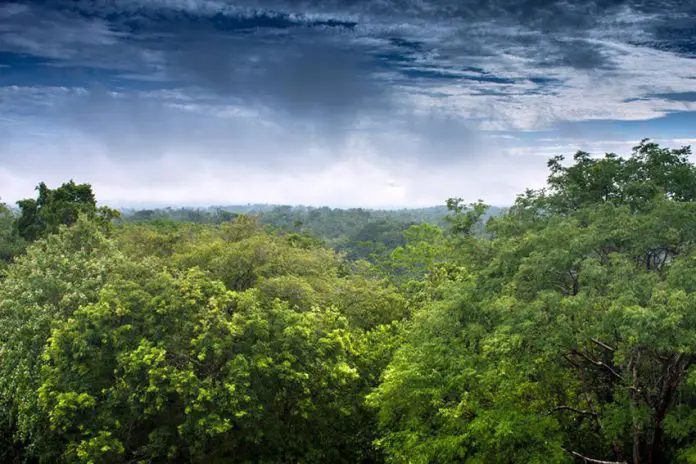Jorge lives in a middle-sized town about 30 minutes from the Mexico-Guatemala border. His wife is friendly with his neighbor’s spouse, but his neighbor is almost never there.
About once every month or so he returns, often with his brother, and they sit in front of their house, garrulous and talkative, catching up on the latest happenings. Jorge never asks what the neighbors do for work — when something isn’t obvious it can be better not to know.
Last summer the brothers invited Jorge on an overnight fishing trip, to what they said would be a secret spot in the jungle on the border. Jorge felt uneasy about it but felt he had no choice but to accept. The three men left after dark and started driving to the unknown spot, which Jorge had assumed would be 20 or 30 minutes away; three hours later they were still driving and by this point completely off-road, on tracks that were barely present as the vehicle passed through heavy brush.
At about 1:00 a.m., when they finally stopped in front of an enormous lagoon alongside a little wooden jetty and a rickety boat, Jorge was relieved. “At that point I thought maybe it was really just a fishing trip after all, and, honestly, I breathed a big sigh.”
The fishing for its part was quicker than expected, and within an hour they had filled the boat and four big boxes full of huge specimens. On returning to land they lit a fire and started cooking as much as they could eat, and as they finally left at dawn the brothers said they had one more stop to make.
Half an hour later the 4×4 full of fish pulled into another clearing, smaller this time, completely empty. They parked, got out, and 20 yards away from the vehicle the brothers started scratching around in the dirt, unearthing a metal door in the ground. They unlocked it with two separate keys, and motioned Jorge to join them, then stepped down into an underground concrete room.
One brother switched on an air-conditioning unit, the other an overhead light, then the first opened a fridge and pulled out a six-pack of beer. Now the room was lit, Jorge could see that the walls were lined with semi-automatic weapons and other high-end military hardware; the snack spot for the brothers also doubled as a concealed arsenal in the middle of the jungle.
Borders the world over are complicated, whether those divided by natural landforms or an artificially conceived line in the sand, what there is on one side is different to what there is on the other, and the push-me/pull-you of this division generates all manner of behavior and commerce, legal and illicit.
The Mexico-Guatemala border is no different but, outside of perhaps the only two significant border crossings at Chetumal in Quintana Roo and Tapachula in Chiapas, much of the rest of this frontier is really a nebulous, non-linear space which only exists in maps and legislative contexts. On the ground, the fundamentals are that it is a wild and rule-free place for both animals and humans.
In Mexico, the vast majority of media coverage and interest looks north, to the border between the supposed first and developing world, while Mexico’s southern edge with Guatemala and Belize receives scant attention. It is of little geopolitical interest beyond when journalists and news cycles cover migration from Central America, which in any case is also a topic which has more bearing on the northern border than its southern counterpart.
When Guatemala closed its borders at the very start of the ongoing pandemic, for instance, no one even blinked; there is almost no international cross-border commerce to speak of in the area, and those who flit across the imagined line do so unpoliced anyway, so nothing really changed.
The fundamentals of the southern border are that the section which Mexico shares with Guatemala runs for 871 kilometers (541 miles) and connects the Mexican states of Chiapas, Tabasco and Campeche with north and west Guatemala, and to the east a small section connects Mexico with Belize and runs for a much shorter 250 kilometers, almost entirely along the Hondo river which separates the two.
In large part, the majority of the border area continues to be jungle or river surrounded by jungle, an area which, both traditionally and more contemporaneously, was inhabited by bandits. Of late, these are not the recognizable bandits of yesteryear, but rather individuals and groups who find niches in the no man’s land to leverage local components of much bigger economies, most obviously the illicit movement of people and — of course — narcotics.
In some areas, indigenous communities continue to exist in relative, isolated autonomy, often leading a cross-border existence where the line of separation is largely nominal, except in times of geopolitical crisis. In Frontera Corozal, for instance, the Ch’ol Mayans of the area live on both sides of the Usumacinta River and have regular, daily contact as though there was no division at all.
In fact, on the Mexican side, all local cell phone numbers are Guatemalan, given that Tigo has much better coverage than Telcel in the area. Even more interestingly, during the Guatemalan civil war the Ch’ols from the eastern side almost all moved to the Mexican bank of the river to seek refuge, and stayed for 10 years until the situation cooled enough for them to return.
In many ways the southern border is a throwback to what borders used to be and so rarely are anymore: amorphous and unmediated spaces which consist much more of a border area than a line in the sand.
They are an entire region which operates to different rules, and give rise to drifting between communities, making stories like Jorge’s, outlandish as it may seem, a common occurrence.
